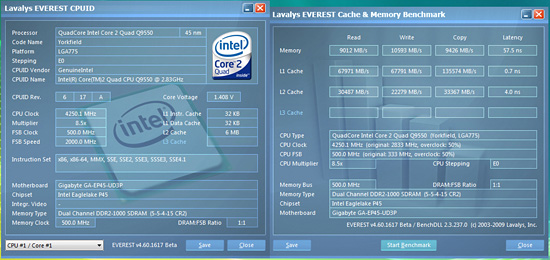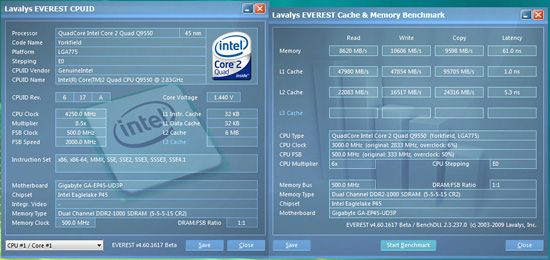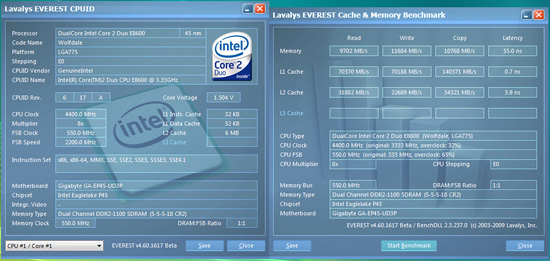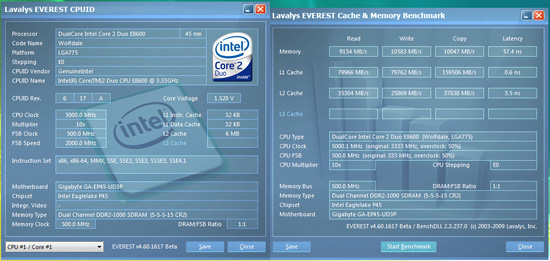Gigabyte GA-EP45-UD3P - P45 at its Finest
by Gary Key on February 3, 2009 12:15 AM EST- Posted in
- Motherboards
Overclocking
GIGABYTE advertises the GA-EP45-UD3P as a mainstream motherboard and will nudge users towards their enthusiast-oriented EP45 Extreme series or X48 boards for overclocking duties. We are here to say that is a big mistake based upon our results. We expected solid overclocking based on the BIOS design and board components, but this board clocked just as well or better than any upper-end P45 or X48 boards we have in the labs.
True, there are boards that might hit higher FSB rates or offer better memory performance, but we are concentrating on mainstream overclocking abilities in our tests. We focus on the type of overclocks that support 24/7 operation with reasonable cooling and the ability to run a multitude of programs without a problem. We are not optimizing for SuperPI or 3DMark records; it's more like trying to keep our bank records safe from a crash (sadly, there's nothing we can do about banks crashing).
We put an emphasis on stability during our testing sessions so we test with real world applications ranging from a variety of games to digital imaging software to various audio/video creation programs, along with the normal OCCT and PCMark Vantage tests.
Q9550 4GB Results

Our maximum overclock on air-cooling with the Q9550 resulted in a 4.25GHz clock speed at a respectable 500MHz FSB with our 4GB G.Skill memory kit set to DDR2-1000 at 5-5-4-15 timings. The primary voltages settings were 1.36V NB, 1.38V VTT, 1.70V PLL, 2.00V VDimm, and 1.425V for the CPU. We tried to run the memory higher, but could not get stability at the DDR2-1200 mark in Nero Recode or Crysis. Vdroop was approximately -.02V with Load Line Calibration (LLC) enabled and -.035V with it disabled at idle. Under load Vdroop was -.025V with LLC enabled and -.05V with it disabled.
Q9550 8GB Results

We were able to reach the same 8.5x500 for a 4.25GHz clock speed with 8GB at DDR2-1000 with 5-5-5-15 timings. However, our voltage settings changed to 1.38V NB, 1.40V VTT, 1.70V PLL, 2.06V VDimm, and 1.450V for the CPU to compensate for the additional load on the MCH. Under load Vdroop was -.02V with LLC enabled and -.05V with it disabled.
E8600 Results

Our maximum overclock on air-cooling with the E8600 came with a blistering 4.40GHz clock speed at a fully stable 550MHz FSB rate. Our 4GB G.Skill memory kit allowed us to reach DDR2-1100 at 5-5-5-18 settings. We used the following voltage settings: 1.40V NB, 1.36V VTT, 1.72V PLL, 2.08V VDimm, and 1.500V for the CPU. We had to drop to 8x500 to get 8GB stable while keeping VDimm below 2.1V, PLL below 1.80V, and NB below 1.50V. Vdroop was approximately -.01V with Load Line Calibration (LLC) enabled and -.025V with it disabled at idle. Under load Vdroop was -.02V with LLC enabled and -.04V with it disabled.
E8600 Additional Results

We knew we had a good E8600, so we pulled out our CoolIT Systems Freezone Elite kit and decided to see how far we could get on this board. We ended up at 5GHz with a 10x CPU multiplier and FSB set to 500. We installed 8GB of memory and ran it at DDR2-1000 with 5-5-5-15 timings. We used the following voltage settings: 1.42V NB, 1.40V VTT, 1.76V PLL, 2.04V VDimm, and 1.5675V (1.550V was stable after raising NB to 1.46V) for the CPU. This is the first time we have reached a stable 5GHz with this processor in a P45 board. Vdroop was similar to our results above.
Thoughts
We have absolutely no concerns about recommending this board for 24/7 500FSB+ use. This board overclocks quad-core chips just as easily as it does dual-core offerings, which is a feat that most P45 boards cannot accomplish. Depending on your processor choice, the Northbridge (MCH) and PLL voltages are two prime settings open for reduction. We only utilize retail processors so it is up to luck if we get a good processor or not for overclocking.
We ultimately ran our E8600 at 585FSB stable in all our applications except for Adobe Premier Pro 4.0; it would constantly hang at any FSB setting above 550. We also tried to verify GIGABYTE’s claim of DDR2-1366 support but our 2GB DDR2-1250 memory kit was unable to get above 1300. However, this is the first board that ran it stable at 1300 so we think it is just a limitation of our memory kit - or reluctance to push more than 2.4V into it.
In regards to voltage regulation, we think the GA-EP45-UD3P has excellent voltage output. We checked all the major voltages with a DMM and found very little variance between what you select in the BIOS and what the board actually outputs. The VTT, PLL, DIMM, and other voltages are accurate and stable across the spectrum. They show no real variances between idle and load states; if anything, we would see a small +.005V rise at times. As discussed, there is line droop on VCore when switching from idle to load situations. However, we found it was not substantial enough to affect stability or overclocking capabilities.
















73 Comments
View All Comments
djc208 - Tuesday, February 3, 2009 - link
Thanks for the review. Picked this board up for $100 w/ free shipping from Newegg a few months ago. Looked like a great board for the money, glad to see you agree.I'll have to go back and update my software though, I also didn't notice any real benefits to their power program, and the OC program would hang my XP system.
weh - Tuesday, February 3, 2009 - link
Did you happen to test the pair of GSata ports in addition to the Sata ports connected directly through the ICH10R? Are they equally as responsive?Also, if you were to attach a pair of drives in either RAID-0 or RAID-1 to the ICH10R Sata ports, is throughput to a third (or fourth) drive affected?
Two specific examples: 1) Two (2) VelociRaptors attached to Sata_0 and Sata_1 in a RAID-0 array containing OS and apps with data storage on a Caviar "black" 640GB drive attached to Sata_2; and, 2) A single VelociRaptor attached to Sata_0 containing OS and apps with a pair of Caviar RE3 drives in RAID-1 attached either to Sata_1 and Sata_2 or to GSata_0 and GSata_1.
Gary Key - Wednesday, February 4, 2009 - link
Hi,Yes, we tested the secondary controllers and I will update the article to include those results. We had a bit of trouble on the AMD board (Phenom II) getting consistent results but a BIOS update cured that problem last night. The X58 article linked in the above response will give you an idea about the secondary controller performance until I get the article updated.
Personally, I would only use the GSata (JMB363) ports as a last alternative but that is just me. Those ports are on the board as a marketing checklist feature. ;) We have not noticed any performance degradation on the ICH10R with a RAID setup on two ports and single drives on the other ports. Running drives off the GSata ports will not affect performance on the ICH10R ports, at least with a two drive configuration on the ICH10R and two drives on the GSata controller. I have not loaded all eight ports and tried that but that is a good question to answer in the future if I can get enough of the same drive model for testing.
weh - Wednesday, February 4, 2009 - link
Thank you for the response. I suspected that the GSata ports would behave much like those on the X58 board, but it's nice to know. By the way, your review of the X58 boards is the ONLY review I've been able to find on ANY review site that compared performance between "native" south bridge Sata ports and auxiliary Sata ports.I'm building four machines to be used by photography professionals. Performance is paramount, but so is redundancy. Each setup will consist of a computer with an os/applications drive (Velociraptor) and a pair of drives in RAID-1 for working space (either a pair of Caviar "blacks" or the RE3 units) and fourth drive inside the case used for continuous backups (probably one of the Caviar "green" drives). They also want 3 optical drives in each machine (they archive 3 of everything and want the ability to burn all 3 at once), so I'm running out of ports rapidly. I'll probably attach the three primary drives and the three optical drives to the six native sata ports and the backup drive and an eSata port to the two auxiliary GSata ports.
Zoomer - Tuesday, February 10, 2009 - link
I would recommend a SSD for OS/apps drive, but that's just me. Raptor? Slow. ;)The0ne - Tuesday, February 10, 2009 - link
Most definitely go with a stand alone CD duplicator. It's small, cheaper and easier to manage for what you've outlined.bobbyto34 - Monday, February 9, 2009 - link
You should perhaps consider buying a special "dedicated" computer for burning data. There are several robots (mechanized arms + software) to burn DVD/CD easily :example :
- connect to the robot via the software
- choose file + label for DVD print
- launch burning
New tasks are paused until their turn arrives.
Primera or Rimage provide these types of products.
semo - Tuesday, February 3, 2009 - link
to add to the questions above, what is gsata? and why do boards have 2 sata contollers these days. is it so tha one set can be used for os and app drives and the other set for high capacity data drives?review was good though and this board is smoking. plenty of peripheral slots and very well placed. with current oversupply and competition you can get cheapo memory, one of these boards and a mid range processor and overclock everything with relative ease. i don't thinkg we've had it so good since the amd barton core days
weh - Tuesday, February 3, 2009 - link
GSata is Gigabyte's add-on SATA controller, an additional controller for two additional SATA drives which can be run individually, in RAID-0 or in RAID-1. Gigabyte also includes an controller for a single channel parallel IDE (P-ATA) port (2 drives, master & slave).What I'd like to know is how drives connected to this alternate controller's ports compare in throughput to those connected to the "native" ICH10R Sata ports.
I also want to know if adding a RAID array pair affects the performance of a drive outside the array as compared to the drive's performance when the RAID array is not present at all. In other words, does the presence of a RAID array impede the performance of another drive connected to the same controller?
semo - Tuesday, February 3, 2009 - link
i don't know about the raid question (interesting to find out) but i know that the ich10r sata controller is pretty good and seems better than the secondary contollers.http://www.anandtech.com/mb/showdoc.aspx?i=3471&am...">http://www.anandtech.com/mb/showdoc.aspx?i=3471&am...